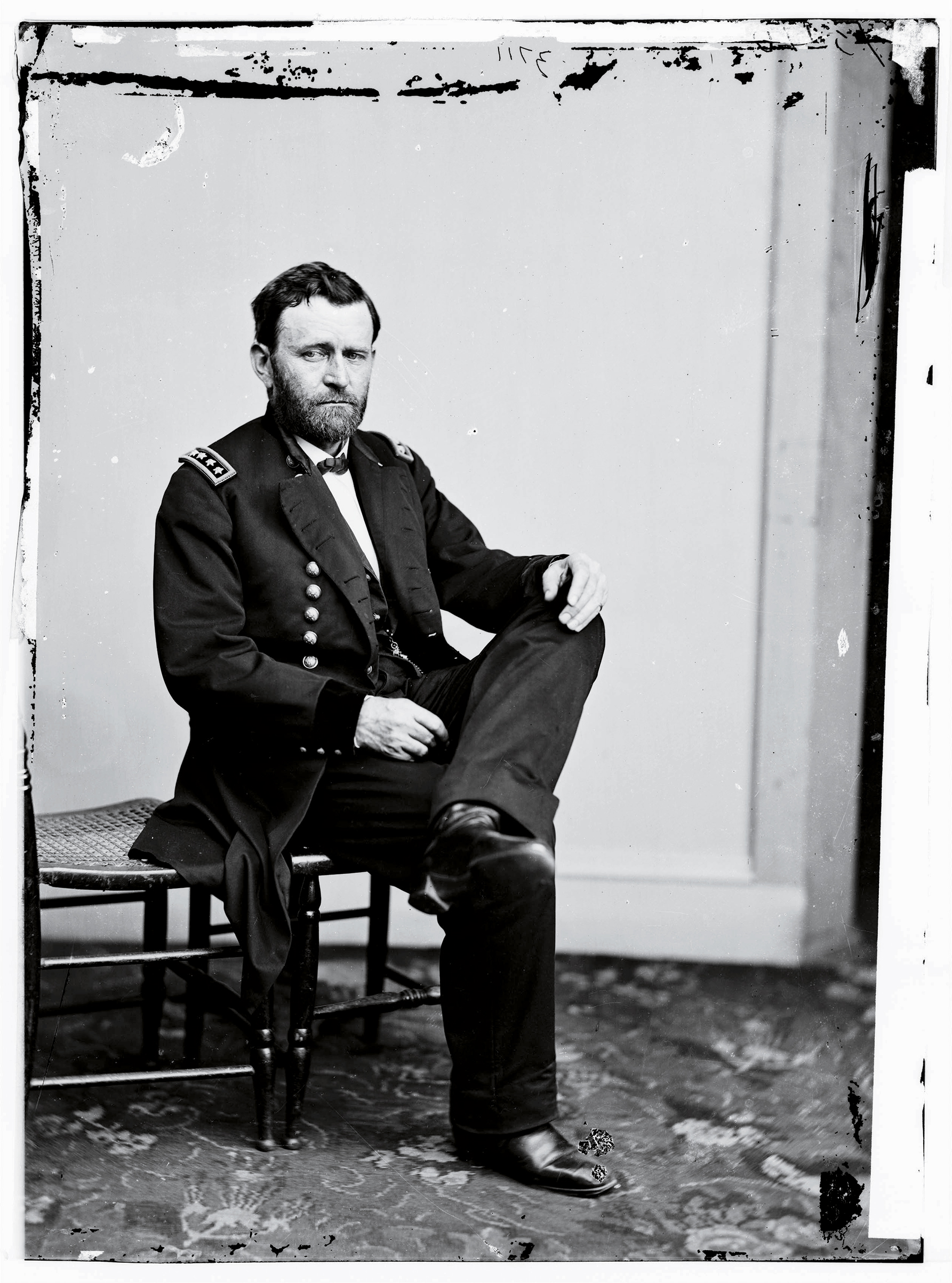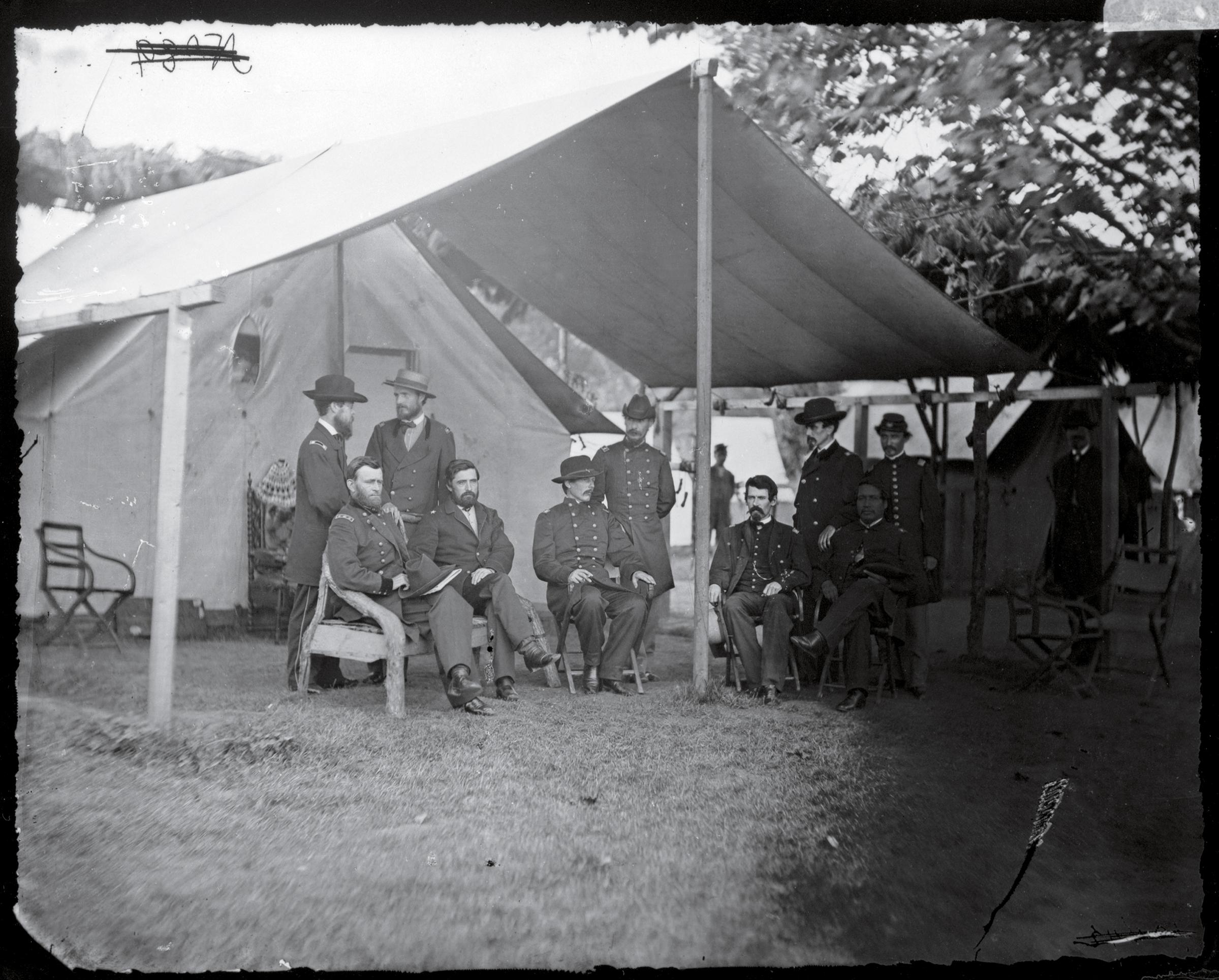
Above the entrance to Grant’s Tomb in New York City, figures representing Peace and Victory frame an inscription. The slogan’s brevity belies the difficulty of the idea: Let us have peace.
On a recent afternoon, the biographer Ron Chernow perched on a nearby bench to discuss his latest offering, Grant, a sweeping study of the Civil War general and U.S. President whose body lies within that monument. Gazing up at North America’s largest mausoleum, Chernow recalls that Walt Whitman dubbed Ulysses S. Grant and Abraham Lincoln the two “towering majestic figures” of the Civil War.
“Most living Americans can’t understand why someone like Walt Whitman would have talked about Ulysses S. Grant in the same breath,” Chernow says. “If they came up here, I think most of them would be startled.”
For a man who studies the past, Chernow has a knack for connecting with the present. Titan, his John D. Rockefeller biography, emerged in time to draw comparisons to Bill Gates, amid antitrust complaints facing Microsoft. And Alexander Hamilton had a modern message for Lin-Manuel Miranda, whose musical Hamilton has enthralled the nation. Chernow chalks up his track record as one for “the annals of dumb luck,” but Grant has the potential to be his timeliest book yet.
Chernow wanted to write novels; the only history course he took as an undergraduate was about Ireland, so he could understand Ulysses better. But he wound up focusing on nonfiction, and won the National Book Award on his first go. In the years that followed, the soft-spoken native New Yorker turned from tycoons (Rockefeller, J.P. Morgan, the Warburgs) to political leaders (Hamilton, George Washington). He thus became what Salman Rushdie calls an expert in “the values of America as expressed through the lives of the Founding Fathers.”
As Chernow leaves the founding era behind, biography as a vehicle for American values will only get trickier–and more urgent. The Civil War has always had die-hard history buffs, but right now Americans are wrestling with its meaning in unusually public ways. As conversations about states’ rights, federalism, racial injustice, white supremacy and civil divisiveness take place, there’s a natural tendency to look for answers in a past explosive moment. But engage in those conversations even a little bit and one reason why they’re so difficult becomes clear: many people still disagree on the basic facts of what happened. “This is a case where knowledge of history is not just a nice adornment to your life,” Chernow says, “but actually is going to affect how you respond to a lot of different contemporary issues.”

The details of Grant’s life are subject to the confusion that engulfs the period too. It’s no coincidence that Chernow’s book clocks in at more than 1,000 pages. Its subject became a Civil War hero for wringing surrender from Robert E. Lee but is also dogged by rumors of being a corrupt politician, not to mention a drunk whose memoirs were ghostwritten by Mark Twain. This is a man who was once known as “Useless Grant,” who ended up leading his country in war and peace, taking a grand world tour, losing his fortune in a Ponzi scheme and writing a best-selling memoir as his final act. (He also had a family and, by way of disclosure, this writer is married to a many-generations-removed descendant.) He battled addiction and an albatross of a father. He was ensnared in scandal and escaped assassination attempts. He also oversaw a period of such rapid progress toward equality that its ramifications are still felt today.
And that’s where the real disagreements set in. Behind one of the more fundamental feuds about the Civil War is what’s known as the Lost Cause narrative, a view that emphasizes the Confederate fight for states’ rights. (Chernow points to the historical record left by Confederate and Union fighters, which shows a general agreement that the war was about slavery.) The theory also holds that the South lost the war because even Lee’s military genius couldn’t topple the brute force of Northern manpower and matériel. As a result, the Lost Cause narrative would lay claim, for many years, to Grant’s military reputation. But there are clues that things are changing.
“In order to build up Robert E. Lee, you’ve got to knock down Ulysses S. Grant,” says John F. Marszalek, executive director of the Ulysses S. Grant Association and editor of a new annotated edition of The Personal Memoirs of Ulysses S. Grant, which will also be released in October. It’s an ironic choice of words as statues of Lee are literally being brought down. Chernow believes that Confederate monuments should be moved to museums so they can serve to educate rather than endorse. As for occasional talk of removing Grant statues because he once issued an order expelling Jews from a military area under his control, Chernow says the people who call for that usually don’t know the full story, in which Grant made up for his error with later public support of the Jewish community.
In what Chernow describes as a “historical seesaw,” Grant was on top during the war. After Grant’s death, it was Lee’s turn. Now Grant is back–maybe to stay.
Perhaps one of the most obvious signs that change has already begun can be seen in how Grant shakes out in lists of the best and worst Presidents. In 1948, when Arthur M. Schlesinger asked historians to rate the Chief Executives, Grant landed with a thump in the failure category as one of the two worst Presidents ever. (Sorry, Warren G. Harding.) He stayed in the basement for decades. Yet in a 2017 C-SPAN ranking, he came in at a rather healthy 22nd place. Historians including H.W. Brands and Ronald C. White have also recently taken Grant as their subject, and the Grant Library at Mississippi State is moving to new digs in November. Chernow calls it “a bull market for Grant.”
Chernow highlights one reason for the shift. “Ultimately,” he writes in Grant, “the appraisal of Grant’s presidency rests upon posterity’s view of Reconstruction.”

That period after the Civil War remains one of the most contentious episodes in the nation’s past. Over the course of roughly a decade, under federal oversight and with Grant’s support for their cause, freed slaves won liberties that would in many cases not be seen again for nearly a century. Chernow recalls that he was shocked to find a telegram that had been sent to Grant in 1867 from New Orleans with a report on the desegregation of the streetcars. The very rights that were so longed for in the mid-20th century had already been won and exercised, a reminder of how easily progress can be undone.
Freedmen soon began to lose much of what they’d won thanks to political maneuverings, national apathy and a concerted effort to reinstitute oppression as the Jim Crow system developed. The Lost Cause view of Reconstruction–as a period of federal overreach and failed reform–came to dominate too as what Chernow calls historical amnesia set in.
“Reconstruction was the dirty little word we were taught, whether you grew up in the North or in the South,” echoes Christy Coleman, CEO of the American Civil War Museum in Richmond, Va. Because Reconstruction had such a reputation as a failure, for a long time relatively little scholarship on the period was undertaken, says Coleman, who has made news as a black woman at the head of a Civil War institution. Now she sees historians approaching the era with fewer assumptions–and, accordingly, a wide range of Americans reconsidering it. It’s “an extraordinary outcome,” she says. Hence, the seesaw’s swing.
Chernow doesn’t see his job as political. Rather, he says, he offers facts so people can build informed opinions. But helping Americans get to know their own past has new urgency in light of the undeniable divisions in society today. “Politics boils down to the stories we tell ourselves. And unfortunately, we tell ourselves different stories,” Chernow says. “Unless we know where we’ve been as a country, we don’t know where we are or where we are going.”

For Chernow, life post-Hamilton has been “enchanting” but hasn’t changed very much, even though he gets a cut of the theatrical bounty and the book has sold more than 1 million copies across all formats. Things were good before, and they’re only that much better now, he says tactfully. But he’s not shy about acknowledging the musical’s impact on other people. It has been a unique cure for what he calls “creeping historical illiteracy” among the public, and he hopes that Miranda will someday return to history for inspiration–though “not even Lin wants to compete with Hamilton,” he jokes. For now, if Grant can help make Reconstruction less of a “black hole” in the past, Chernow will be happy.
And the collective future of the nation is not the only matter on which the past can shine a light. In all the success of Hamilton, one of the most poignant aspects for Chernow has been the reminder of how we can look for individual guidance from the past. The audience members to whom Chernow has spoken, just after they’ve absorbed the musical’s meditations on Hamilton’s legacy, tend to wonder aloud what their own impact will be.
When it comes to Grant, Chernow has a suspicion that this effect will be magnified. After all, he notes, this book is unlike anything he’s ever written in that its subject–who, in a typical anecdote, lost the key to a trunk of clean clothes just before he was supposed to meet Lincoln at the White House–doesn’t seem destined for success. “I’m sure there are many more people who can identify with failure and hardship in life,” Chernow says, “than with the success of an Alexander Hamilton or a John D. Rockefeller.”
Readers may take inspiration in knowing that the man in the dirty clothes became President. They may also take to heart that great men and women can rise and fall and rise again–and that for Grant, such was the case even though his success has not yet included realization of the hope he expressed in 1868: “Let us have peace.” History has its eyes on us.
More Must-Reads from TIME
- Why Trump’s Message Worked on Latino Men
- What Trump’s Win Could Mean for Housing
- The 100 Must-Read Books of 2024
- Sleep Doctors Share the 1 Tip That’s Changed Their Lives
- Column: Let’s Bring Back Romance
- What It’s Like to Have Long COVID As a Kid
- FX’s Say Nothing Is the Must-Watch Political Thriller of 2024
- Merle Bombardieri Is Helping People Make the Baby Decision
Write to Lily Rothman at lily.rothman@time.com